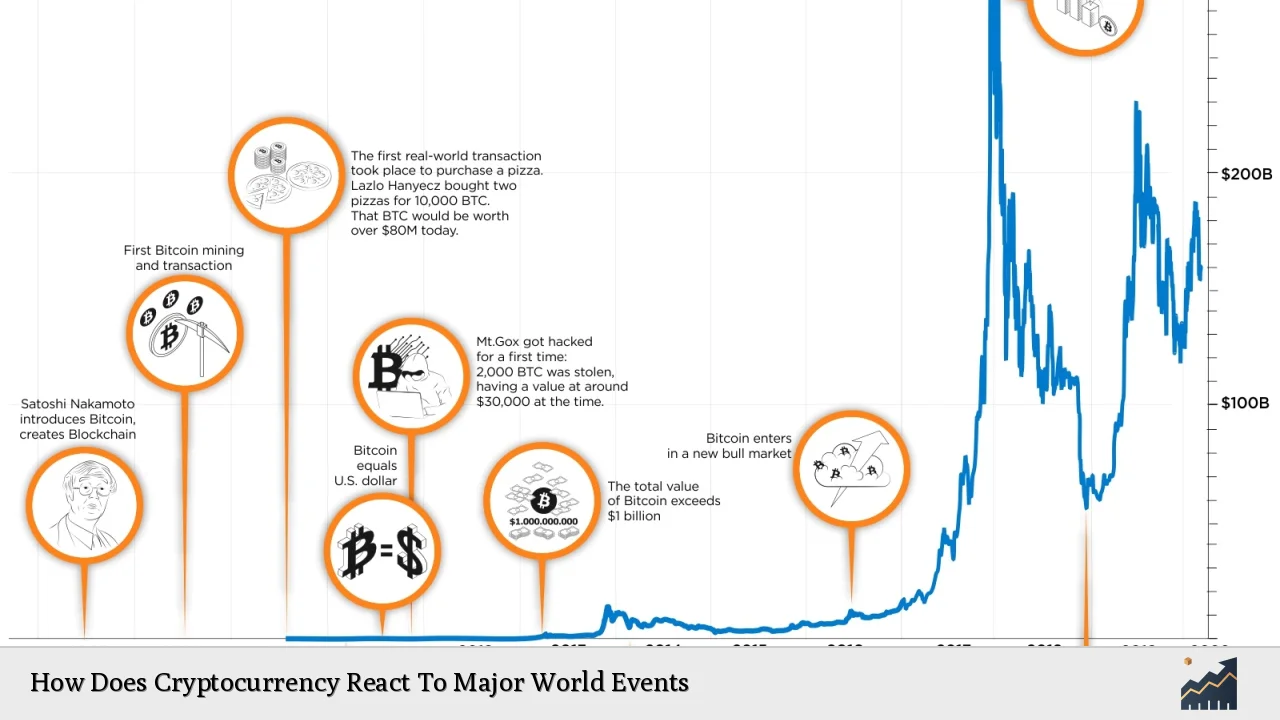Cryptocurrencies have emerged as a significant asset class in the financial landscape, often reacting dynamically to major world events. Unlike traditional assets, cryptocurrencies can exhibit unique price movements influenced by geopolitical tensions, economic crises, regulatory changes, and technological advancements. This article delves into how cryptocurrencies respond to such events, providing a comprehensive analysis of market trends, implementation strategies, risk considerations, regulatory aspects, and future outlooks.
| Key Concept | Description/Impact |
|---|---|
| Geopolitical Tensions | During conflicts or political unrest, cryptocurrencies like Bitcoin are often viewed as safe-haven assets, although their performance can vary significantly based on investor sentiment and market conditions. |
| Economic Crises | In times of economic instability, cryptocurrencies may see increased adoption as individuals seek alternatives to traditional fiat currencies. |
| Regulatory Changes | New regulations can lead to significant price fluctuations; positive regulatory news tends to boost prices while negative news can cause sharp declines. |
| Technological Developments | Advancements in blockchain technology or security improvements can enhance investor confidence and drive prices higher. |
| Market Sentiment | The collective mood of investors heavily influences cryptocurrency prices. Positive news can lead to bullish trends, while negative news often results in sell-offs. |
Market Analysis and Trends
The cryptocurrency market is characterized by high volatility and rapid price changes influenced by various global events. Recent trends indicate that cryptocurrencies are increasingly viewed as alternative investments during periods of uncertainty. For instance, during geopolitical crises like the ongoing conflicts in the Middle East or the Ukraine-Russia war, Bitcoin has been perceived as a digital gold—a store of value amid traditional market turmoil.
Current Market Statistics
As of December 2024, the total market value of cryptocurrencies has surged to approximately $2.3 trillion, reflecting an 89% increase from the previous year. Bitcoin reached an all-time high of over $107,700 in mid-December 2024 due to rising institutional investment and favorable regulatory developments. The number of individuals holding over $1 million in crypto assets has also seen a dramatic rise, indicating growing wealth concentration within this asset class.
Implementation Strategies
Investors looking to navigate the complexities of cryptocurrency markets should consider several strategies:
- Diversification: Incorporating a range of cryptocurrencies can mitigate risks associated with individual asset volatility.
- Staying Informed: Keeping abreast of global news and regulatory changes is crucial for making timely investment decisions.
- Utilizing Technical Analysis: Employing chart patterns and trading indicators can help predict short-term price movements based on historical data.
- Long-Term Holding: Many investors adopt a buy-and-hold strategy during uncertain times, betting on the long-term appreciation of digital assets.
Risk Considerations
While cryptocurrencies offer significant opportunities for returns, they also come with inherent risks:
- Volatility: The cryptocurrency market is known for its price swings; investors must be prepared for sudden drops as well as spikes.
- Regulatory Risks: Changes in government policies can impact market dynamics significantly. For example, China’s crackdown on cryptocurrency mining led to a sharp decline in Bitcoin’s price in 2021.
- Security Threats: Cybersecurity remains a concern; hacks and breaches can lead to substantial financial losses for investors.
Regulatory Aspects
Regulation plays a critical role in shaping the cryptocurrency landscape. In 2024, several countries have moved towards establishing clearer frameworks for digital assets:
- Positive Developments: The approval of Bitcoin ETFs in major markets has led to increased institutional participation and confidence in cryptocurrencies.
- Ongoing Challenges: Despite progress, many regions still grapple with regulatory uncertainty that could hinder growth. Investors should remain vigilant about potential changes that could affect their holdings.
Future Outlook
The future of cryptocurrency appears promising yet uncertain. Key factors influencing this outlook include:
- Technological Innovation: Continued advancements in blockchain technology could enhance the utility and security of cryptocurrencies.
- Institutional Adoption: As more financial institutions embrace digital assets, we may see increased legitimacy and stability within the market.
- Global Economic Conditions: Economic factors such as inflation rates and central bank policies will significantly impact investor behavior towards cryptocurrencies.
Conclusion
Cryptocurrencies react uniquely to major world events due to their decentralized nature and the evolving perceptions surrounding them. While they offer exciting opportunities for investment, potential investors must navigate a landscape filled with volatility and uncertainty. By understanding how these assets respond to global events and implementing sound investment strategies, individuals can better position themselves within this dynamic market.
Frequently Asked Questions About How Does Cryptocurrency React To Major World Events
- What types of world events most influence cryptocurrency prices?
Geopolitical tensions, economic crises, regulatory changes, technological advancements, and significant corporate endorsements are key influencers. - How do geopolitical tensions affect cryptocurrency?
During geopolitical crises, cryptocurrencies may be seen as safe havens; however, their performance can vary based on investor sentiment. - What role do regulations play in cryptocurrency markets?
Regulatory developments can lead to significant price fluctuations; positive regulations often boost prices while negative ones can cause declines. - Can technological advancements impact cryptocurrency prices?
Yes, improvements in blockchain technology or security measures typically enhance investor confidence and may drive prices higher. - How should investors prepare for market volatility?
Diversifying portfolios, staying informed about global news, utilizing technical analysis tools, and adopting long-term holding strategies are advisable. - What is the current state of the cryptocurrency market?
The total market value of cryptocurrencies reached approximately $2.3 trillion in December 2024, with Bitcoin hitting an all-time high above $107,700. - What are the risks associated with investing in cryptocurrencies?
The main risks include high volatility, regulatory uncertainties, cybersecurity threats, and market sentiment shifts. - What does the future hold for cryptocurrencies?
The future looks promising with ongoing technological innovations and increasing institutional adoption; however, economic conditions will play a crucial role.

